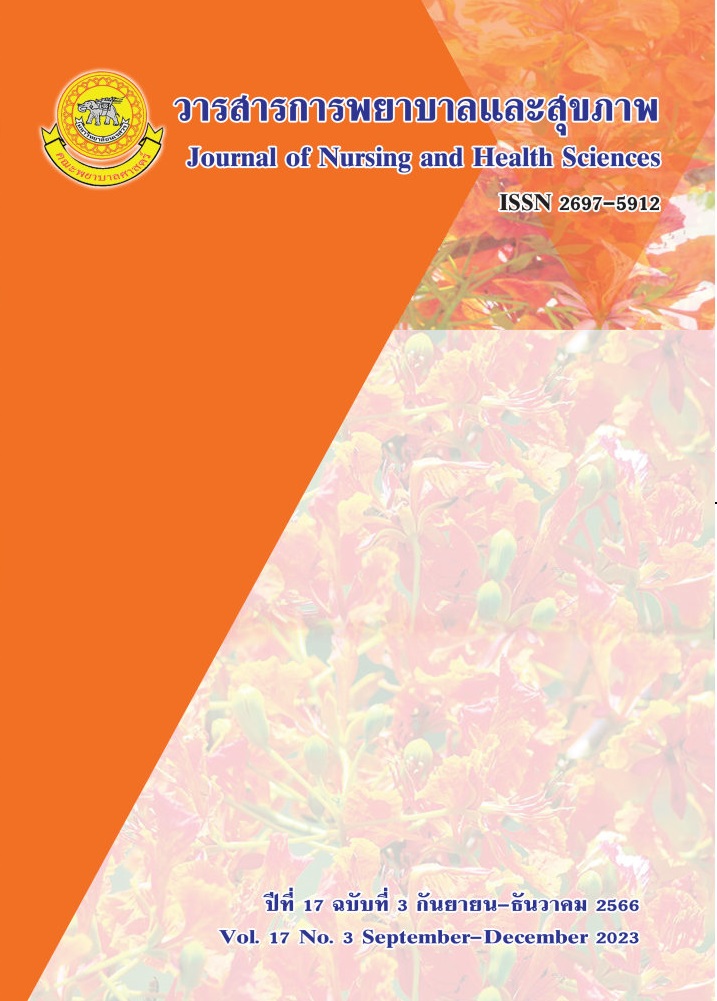The Effects of Self-efficacy Enhancement Program on Stroke Prevention Behavior and Blood Pressure among Patients with Hypertension
Main Article Content
Abstract
The purpose of this quasi-experimental research was to study the effects of self-efficacy enhancement program on stroke prevention behavior and blood pressure among patients with hypertension. Sample were 64 patients with hypertension, who received medical treatments from the sub-district health-promoting hospital in Nakhon Panom province. The sample were assigned into the control and experimental groups, which included 32 patients in each group. The control group received routine nursing care, whereas the experimental group received self-efficacy enhancement promotion program for 8 weeks. The instrument was the Self-efficacy enhancement program among patients with hypertension. Data were collected by using the self-efficacy enhancement and stroke prevention behavior of hypertension patient questionnaire. This research tool had the Cronbach’s alpha coefficient of 0.87 and 0.80. Sphygmomanometer were tested for their biometric property. Data were analyzed by using the descriptive statistics, Chi-Square test, Paired t-test , and Independent t-test.
The results revealed that mean scores of self-efficacy enhancement and stroke prevention behavior of experimental group after receiving an intervention were higher than those of before receiving and higher than the control group (p < .001) and mean systolic blood pressure and diastolic blood pressure after experiment were lower than before experiment and lower than the control group (p < .001). Therefore, the Self-efficacy enhancement promotion program can change health behaviors and reduce blood pressure levels of patients with hypertension and can be further applied to promote self-care in the patients with hypertension.
Article Details

This work is licensed under a Creative Commons Attribution-NonCommercial-NoDerivatives 4.0 International License.
References
Bandura , A. (1977). Self-efficacy :Towerd a unifying
theory of behavioral chang. Psychological
Review, 84, 191-125.
Bandura, A. (1997). Self-Efficacy: The Exercise of Control.
New York: W. H. Freeman and Company.
Bunchuai U. (2017). The Effects of Health Promotion
Program for Hypertension, Hypertension Elderly
Case Study: Thri tong Tumbon Health Promotion
Hospital Chai Buree District, Surat thani Province.
Journal of Community Health Development
Quarterly Khon Kaen University, 3(2), 231-244.
[In Thai].
Chala-em T. (2018 ). Effects of Physical Activity Promotion
Program in Elderly People with Hypertension:
A Case Study of the KaeNok Temple Community
Health Center, Bangasor Sub-district, Muang
District, Nonthaburi Province. Journal of Nursing
and Education,11(4), 107-125. [In Thai].
Chirawatkul A. (2008). Statistics for health science
research. (4thed.). Khon Kaen: Klungnana
Vitthaya Press. [In Thai].
Cohen J. (1988). Statistical power analysis for the
behavior sciences (2nd ed.).Hillsdale NJ:
Lawrence Erlbaum.
Department of Disease Control. (2017). CVD Risk
Assessment in Diabetic and Hypertension Patients.
Bangkok: Bureau of Non-Communicable Disease.
[In Thai].
Department of Disease Control. (2015). Guidelines
of Cardiovascular Disease Risk Assessment.
Bangkok: Bureau of Non-Communicable Disease.
[In Thai].
Division of Non communicable Diseases.(2019. Number
and mortality rate of stroke.Retrieved 1 April 2022 ,
from http://www.thaincd.com/2016/mission/
documents-detail.php?id=13893&tid=32&gid=
-020 . [In Thai].
Health Data Center. (2022). Stroke prevalence rate A. D.
-2022. Retrieved16 October 2021, from https:/
/hdcservice.moph.go.th/hdc/main/index.php.
[In Thai].
Hoikum A., Piyabanditkul L., & Kittipichai W. (2020).
Factors predicting the occurrence of stroke in
hypertensive patients in Khon Kaen province.
Journal of Health Science research, 20(2), 82-92.
[In Thai].
Khumros W., & Ekpreechakul T,(2019). Cerebrovascular
disease, risk factors, and quality of life: A systematic
review. Chula Med Bull, 1(5), 473-487. [In Thai].
Nilnate N. (2019). Risk Factors and Prevention of Stroke
in Hypertensive Patients. Journal of The Royal
Thai Army Nurses, 20(2), 51-57. [In Thai].
Praklantung sub-district health-promoting hospital.
(2021). Annual report 2021. [place unknown];
[In Thai].
Saguansuk P., & Mekrungrongwong S. (2022).
The Effectiveness of a Self-efficacy Building
Program on Stroke Prevention Behaviors among
Elderly Patients with Chronic illness in Khlong
Khlung District, Kampaengphet Province. The
Southern College Network Journal of Nursing
and Public Health, 9(2), 122-135. [In Thai].
Siriyong W. (2018). Prevalence of Stroke and Stroke Risk
Factors in Kanchanadit Hospital. Region 11
Medical Journal, 32(1), 863-870. [In Thai].
Soontharak O. (2018). A study of risk factors for stroke
among people in Nakhon Phanom province.
NAKHONPANOM HOSPITAL JOURNAL, 5(2),
-38. [In Thai].
Supasri S., Wungrath J., & Boonchieng W. (2021). Effects
of a Health Promotion Program on Perceived
Self-Efficacy and Outcome Expectations on
Self-Care among Elderly with Hypertension,
Chiang Rai Province, Thailand. Thai Journal of
Public Health, 51(1); 33-42. [In Thai].
World Stroke Organization. (2020). Annual Report 2020.
Retrieved 1 April 2022 from https://www. worldstroke.org/assets/downloads/WSO_Annual_
Report_ 2020_online.pdf.
Wutthitham N., Chontong R., & Sompradit CH. (2020).
The effects of Self-efficacy Enhancement
on Blood Pressure Level Controlled among
Hypertension Risk Group, Journal of The Royal
Thai Army Nurses, 21(1), 309-318. [In Thai].


